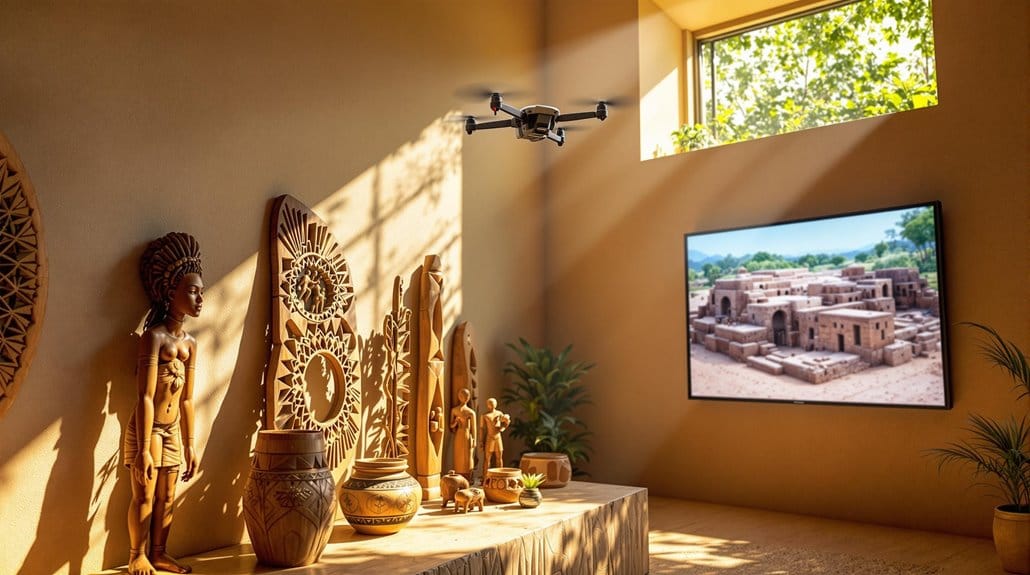Is it true that technology can play an essential role in preserving African heritage? As you consider the potential of tools like 3D printing and digital documentation, you might wonder how these innovations not only protect cultural artifacts but also engage new generations in meaningful ways. The intersection of technology and heritage conservation raises important questions about accessibility and authenticity. What implications does this have for the future of cultural identity in Africa?
Key Takeaways
- 3D printing allows for non-invasive replication of artifacts, preserving their integrity during restoration efforts.
- Digital documentation projects, like the Zamani Project, enhance global access to African cultural heritage.
- AI and machine learning improve data analysis and restoration processes for artworks and historical sites.
- Innovative mapping technologies, such as LiDAR and GIS, facilitate effective management of cultural resources.
- Virtual heritage experiences and digital museums expand engagement and appreciation for African history across diverse audiences.
Historical Significance of African Heritage
The African continent stands as the cradle of human civilization, housing empires and dynasties that have significantly influenced global history. When you explore African cultural heritage, you uncover a rich tapestry woven from ancient achievements, such as Egypt's complex hieroglyphics, which demonstrate advanced communication and record-keeping systems.
This highlights the historical significance of Africa as a center for education and knowledge, where even Greek philosophers sought wisdom.
However, the reliance on oral tradition has posed challenges in documenting this vast cultural wealth. While oral narratives are essential, they sometimes limit the preservation of Africa's diverse history, leading to gaps in understanding.
Moreover, Western narratives have often misrepresented African history, casting shadows on its authentic stories.
The Need for Cultural Preservation
Preserving Africa's cultural heritage isn't just a matter of nostalgia; it's fundamental for maintaining the continent's diverse identities and histories. Cultural preservation plays a significant role in safeguarding African heritage, which encompasses both tangible artifacts and intangible culture.
Without effective preservation efforts, we risk losing essential traditions, practices, and languages that shape our cultural identity and sense of belonging.
The African Union's Agenda 2063 highlights the urgent need for a cultural renaissance. As UNESCO warns, over 2 million cultural sites are at risk globally. This alarming statistic underscores the necessity for collaborative initiatives that harness technological advancement to protect and revitalize our heritage.
Revitalizing endangered languages is particularly important, as these languages carry unique worldviews and knowledge.
When we engage in cultural preservation, we foster a deeper understanding of who we are, both individually and collectively. It's about more than just artifacts; it's about ensuring that future generations can connect with their roots and navigate their identities in an ever-evolving world.
Technology's Role in Heritage Conservation
Innovative technologies are revolutionizing the way we approach heritage conservation in Africa. By integrating advanced tools, you're not just preserving cultural heritage; you're reshaping how communities engage with their history.
Here are some ways technology plays an essential role:
- 3D Printing: This emerging technology allows for non-invasive replication of artifacts, reducing damage from physical handling.
- Digital Documentation: Initiatives like the Zamani Project have digitized over 60 cultural landmarks, enhancing global accessibility.
- AI and Machine Learning: These tools analyze cultural data, document endangered languages, and assist in the restoration of artworks, making preservation efforts more effective.
- Innovative Mapping Technologies: LiDAR and GIS improve documentation and planning, ensuring efficient cultural resource management.
3D Printing and Cultural Artifacts
3D printing is transforming the landscape of cultural artifact preservation, offering unprecedented opportunities for both protection and accessibility. This innovative technology allows you to create precise replicas of delicate items, minimizing physical handling and ensuring their safety through non-invasive methods.
Consider how the Iziko Museums of Cape Town have effectively replicated ancient San rock art, safeguarding original pieces from environmental threats. Similarly, Egyptian researchers have utilized 3D printing to restore damaged hieroglyphs, making accurate reconstructions of historical inscriptions possible.
The integration of 3D-printed bricks at the Great Zimbabwe site exemplifies how modern technology can enhance the restoration of historical architecture, maintaining cultural integrity while providing structural support.
Projects like the Zamani Project showcase the potential of 3D technology in documenting and preserving over 60 cultural landmarks across 16 African Union Member States.
Digital Museums Enhancing Access
Digital museums are revolutionizing how you access and interact with African heritage, breaking down geographical barriers to bring cultural treasures right to your screen.
By offering virtual heritage experiences, these platforms not only enhance global accessibility but also foster a deeper appreciation for your rich history.
As you explore these innovative spaces, you're contributing to a collaborative effort in cultural preservation and education.
Virtual Heritage Experiences
As cultural narratives evolve, virtual heritage experiences like the Milele Museum are transforming how you engage with African history.
These digital museums play a vital role in cultural preservation, making African cultural artefacts accessible to a global audience. You can now immerse yourself in the rich tapestry of African heritage from anywhere, thanks to innovative virtual platforms.
Here are some key aspects of these immersive experiences:
- Enhanced Accessibility: Explore collections that were once limited by geographical barriers.
- Interactive Learning: Engage with educational content that brings diverse African narratives to life.
- Community Connection: Join a network of individuals passionate about preserving and celebrating African culture.
- Restitution Efforts: Support initiatives aimed at returning cultural artefacts to their rightful places.
Global Cultural Accessibility
Virtual heritage experiences have paved the way for a broader understanding of cultural accessibility, particularly in the context of African heritage. Digital museums, like the Milele Museum, are revolutionizing how you connect with history and cultural artifacts, making it easier than ever to engage with African heritage from anywhere in the world.
These platforms not only enhance global accessibility but also serve as crucial resources for cultural preservation, allowing you to explore and appreciate rich narratives that might otherwise be overlooked.
By digitizing collections, cultural institutions promote awareness and counteract negative stereotypes often perpetuated by traditional narratives. You're invited to participate in innovative storytelling and interactive learning experiences that bring these cultural treasures to life.
This shift to digital platforms fosters a sense of belonging, as communities around the globe can unite in their appreciation of African heritage.
As a result, you're not just a passive observer; you become an active participant in the preservation and celebration of these cultural legacies. In this collaborative space, every click helps build a more inclusive understanding of African heritage, ensuring it thrives for generations to come.
Social Media's Influence on Heritage
Social media's power lies in its ability to connect you to rich cultural narratives and artistic expressions from Africa.
By amplifying diverse voices, these platforms encourage you to engage with heritage in ways that resonate today, fostering a sense of community.
As you explore these online spaces, you not only appreciate the past but also contribute to its preservation and evolution.
Engaging Cultural Narratives Online
In today's digital landscape, platforms like Facebook, Instagram, and Twitter have transformed how we engage with African heritage, turning them into crucial venues for cultural exchange and storytelling.
You can explore a wealth of engaging cultural narratives that showcase the richness of African arts and history. These social media spaces foster community and connection, allowing you to participate actively in discussions that matter.
Consider the following key aspects of engaging with African heritage online:
- Documentation: Share and discover crucial information about African arts and history.
- Community: Join vibrant pages and groups that address identity and socio-political issues.
- Interactive storytelling: Enjoy audio-visual content that resonates with younger generations, making cultural narratives more relatable.
- Networking: Connect with artists and organizations, fostering collaborations that amplify African heritage's visibility.
As you navigate these platforms, remember that contemporary African art reflects both the legacies of the past and current environmental concerns.
In this digital age, engaging with African heritage through social media allows you to participate in a dynamic cultural narrative that unites us all.
Amplifying Artistic Voices
Through the power of social media, artistic voices across Africa are gaining unprecedented visibility, reshaping how heritage is understood and appreciated. By hosting dedicated pages for African arts and history, these platforms foster a vibrant community that amplifies artistic voices and cultural narratives.
You'll find audio-visual documentation that enhances engagement with stories deeply rooted in African heritage, allowing these narratives to resonate widely.
Emerging technology plays a vital role in networking and collaboration among artists, cultural advocates, and historians, leading to increased visibility for African artistic expressions. When contemporary African art is shared online, it reflects both rich cultural legacies and pressing socio-political themes, serving as a powerful medium for advocacy and storytelling.
Social media transforms the connection between African artists and their audiences, creating platforms for dialogue and cultural exchange. This interaction not only elevates the visibility of artistic voices but also nurtures a sense of belonging among diverse communities.
The collaborative potential of these digital spaces invites you to engage with and celebrate the dynamic tapestry of African heritage, encouraging a collective appreciation for the continent's rich cultural landscape.
Building Community Connections
Building connections within communities around African heritage has never been more accessible, thanks to the vibrant landscape of social media.
These platforms not only celebrate African culture but also foster a sense of belonging among individuals passionate about preserving their rich heritage. By leveraging social media, you can engage with like-minded individuals and contribute to collective cultural narratives.
Here are some ways social media enhances community connections:
- Dedicated Pages and Groups: These spaces celebrate African arts and history, creating a shared cultural identity.
- Audio-Visual Documentation: Engaging content allows for broader dissemination and appreciation of cultural narratives.
- Networking Opportunities: Online platforms facilitate collaboration among artists and advocates, addressing identity and socio-political themes.
- Contemporary Art Showcases: Social media highlights modern expressions that connect traditional heritage with current societal issues.
Case Studies of Technological Applications
Many organizations and researchers are leveraging technological advancements to preserve Africa's rich cultural heritage. Through innovative applications of 3D printing and digital technologies, they're making significant strides in restoration and preservation efforts. Here are some compelling case studies:
| Project | Technology Used | Impact |
|---|---|---|
| Iziko Museums of Cape Town | 3D Printing | Replicated ancient San rock art, protecting originals from damage. |
| Egyptian Researchers | 3D Printing | Restored damaged hieroglyphs, guaranteeing the writing system's survival. |
| Great Zimbabwe Site | 3D-printed Bricks | Utilized in restoration, showcasing modern methods for historical structures. |
| Zamani Project | Digital Recreation | Created over 60 digital landmarks, enhancing access and preservation. |
These examples highlight how technology, particularly 3D printing, plays a critical role in safeguarding cultural heritage. By combining efforts and sharing knowledge, you're not just preserving artifacts; you're fostering a sense of belonging and identity. The collaboration among institutions guarantees that these treasures remain accessible for future generations, inviting everyone to connect with their rich history.
Collaborative Preservation Initiatives
Collaborative preservation initiatives are reshaping the landscape of cultural heritage maintenance across Africa. By uniting local communities, cultural institutions, and technology, these efforts not only safeguard heritage sites but also foster a sense of belonging among diverse populations.
Initiatives like the Zamani Project showcase how multiple African Union Member States work together to digitally recreate over 60 cultural landmarks, emphasizing shared heritage and regional cooperation.
Consider the impact of collaborative preservation initiatives:
- Partnerships between the British Museum and African museums enhance digitization efforts.
- National 3D cultural preservation programs involve government, universities, and the private sector.
- Skills development programs equip communities with proficiency in 3D technology.
- Open-access data-sharing policies enable innovative uses of 3D data.
These efforts illustrate how technology offers a precise means to preserve cultural heritage while also empowering local communities.
Furthermore, projects like Save The Railway highlight the importance of grassroots engagement in preserving local histories. Through these initiatives, you can witness the profound impact of collaboration, as it connects individuals to their cultural identity while promoting the resilience of Africa's rich heritage.
Future Prospects for Cultural Heritage
The future of cultural heritage preservation in Africa is poised for transformation, driven by advancements in technology and a commitment to community engagement. By investing in 3D printing infrastructure, you can promote technology adoption, making it easier to replicate and share artifacts that are essential to preserving Africa's cultural heritage.
Emerging technologies like AI and machine learning enhance your ability to document and analyze diverse cultural legacies, allowing for a cultural renaissance that celebrates and elevates local traditions.
As you explore expanding international partnerships, consider how resource sharing and crowdsourcing can sustain funding for preservation projects. This collective effort guarantees that communities engage meaningfully, fostering a sense of belonging and ownership over their heritage.
Additionally, establishing clear intellectual property frameworks will empower communities economically, promoting responsible use of technology while safeguarding cultural authenticity.
Developing ethical guidelines for AI in cultural contexts will help you balance technological advancements with the need for community engagement. By prioritizing these efforts, you're not just preserving history; you're shaping a vibrant future where technology and culture coexist harmoniously, guaranteeing that Africa's rich heritage thrives for generations to come.
Frequently Asked Questions
What Technology Is Used to Preserve Cultural Heritage?
To preserve cultural heritage, you can explore various innovative technologies.
Digital archives and virtual museums provide immersive experiences, allowing you to engage with history from anywhere.
3D modeling creates accurate replicas of artifacts, making them accessible without risking damage to originals.
Mobile apps enhance your interaction with heritage sites, while augmented reality brings stories to life, fostering a deeper connection.
These tools encourage collaboration, ensuring everyone has a role in protecting our shared cultural legacy.
How Does Technology Affect African Culture?
Technology profoundly shapes African culture by enhancing digital storytelling and cultural documentation.
You can explore virtual museums that offer immersive experiences, connecting you to rich histories. Social media platforms foster vibrant communities, allowing you to engage with artists and cultural advocates.
Additionally, heritage apps promote local traditions, making them accessible to younger generations. This collaborative approach not only preserves cultural legacies but also nurtures a sense of belonging and pride in shared heritage.
How Has African Culture Been Preserved?
How do you think African culture has managed to thrive through the years?
It's been preserved mainly through oral traditions, cultural festivals, and traditional crafts that bind communities together. Indigenous languages play a crucial role in maintaining these connections, ensuring historical narratives are passed down.
Collaborative efforts among communities also foster a sense of belonging while keeping these rich traditions alive.
This vibrant tapestry showcases resilience and the importance of cultural identity in our shared world.
What New Technology Assisted in the Colonization of Africa?
New technology greatly assisted in the colonization of Africa by enhancing colonial infrastructure and transportation systems.
Communication advancements, like the telegraph, allowed for real-time coordination between powers.
Military innovations, such as the Maxim gun, provided a decisive edge in conflicts.
Mapping techniques improved geographic understanding, facilitating more strategic territorial claims.
Together, these technologies created a framework that enabled European powers to expand their control over Africa efficiently, often at the expense of local communities.
Conclusion
In the vibrant tapestry of African heritage, technology acts as a thread that weaves together past and future. By embracing innovations like 3D printing and digital platforms, you're not just preserving history; you're breathing new life into it. Together, we can transform cultural conservation into a dynamic dialogue that resonates with generations to come. Let's champion these collaborative efforts, ensuring that Africa's rich legacy shines brightly in the global narrative, inviting everyone to partake in its story.









